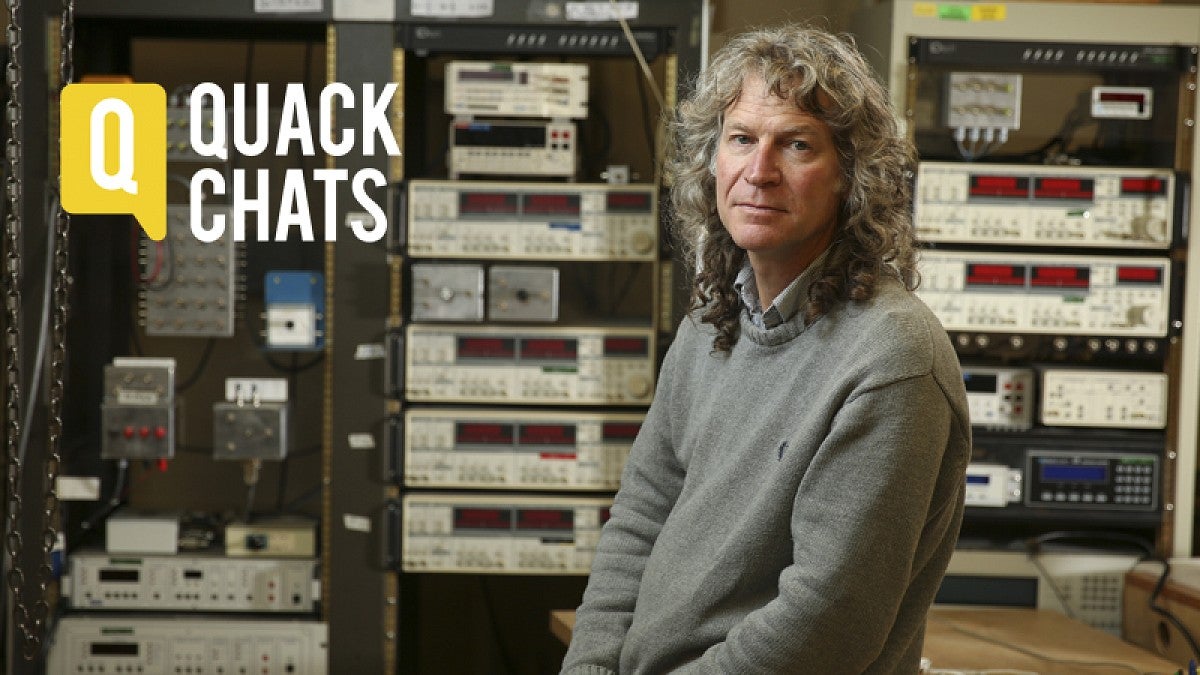Nature and bio-inspiration are the buzzwords that could summarize the Quack Chats pub talk being delivered Wednesday, March 22, by UO physics professor Richard Taylor.
Taylor's talk at 6 p.m. in the back room of Falling Sky Pizzeria in the Erb Memorial Union will convey some of the science behind human vision. Taylor will use lots of imagery to show how his research group is mining fractals to restore sight to the blind.
Fractals? Ever look at trees, clouds or rivers? Have you gazed skyward at faraway galaxies? Ever see a Rorschach inkblot? Ever marveled at a close-up image of a snowflake? Ever see a painting by Jackson Pollock? Then you’ve seen fractals: Objects with irregular curves or shapes — the building blocks of nature.
RELATED LINKS
Facebook Live Preview
Richard Taylor will appear on Facebook Live at 2 p.m., Tuesday, March 21. Join us there.
April 1, Run With a Researcher
Meet up to run or walk, 9 a.m., at the EMU "O" Desk, lower level
“My big driver in life is bio-inspiration,” said Taylor, the head of the UO Materials Science Institute and co-holder of a U.S. patent for the design of any bio-inspired, fractal-based device that might find its way into a human body. “You learn from nature, because nature has had so long to perfect these things. You can learn a lot by going into the human body and looking at its electrical wiring — these things called the nerves. They have fractal patterns.”
Taylor will provide a teaser about his talk on Facebook Live at 2 p.m., Tuesday, March 21. Join the conversation on the UO Facebook page.
Admission is free to Taylor’s talk, but visitors are encouraged to order from the Falling Sky menu, settle in to hear Taylor and pepper him with questions. His presentation will detail past attempts by science to overcome blindness and show how his team is pursuing a miniature, fractal-based retinal implant that would naturally join the electrical network of neurons that make human vision possible.
Did you know that neurons are fractals, too?
“If our implants are to integrate with the body’s electrical wiring, we will have to develop electronics that have exactly the same type of electrical architecture,” Taylor said. “That is a challenge from a fundamental science point of view. The amazing impact is that we can give a million people their sight back by doing that.”
Two of the eye diseases that have Taylor’s attention are macular degeneration, a leading cause of loss of vision for people after age 60, and retinitis pigmentosa, a rare, inherited condition that affects both eyes.
“Being able to see is connected with a reduction of stress,” Taylor said. “There are lots of reasons why going blind is a very bad idea.”
Quack Chats pub talks are held the second and fourth Wednesdays of each month. The summer schedule for June-September will be once monthly. The Quack Chats initiative also includes the monthly Run with a Researcher and other community events involving speakers from the UO faculty.
The tentative lineup for Run with a Researcher on Saturday, April 1, includes Taylor, along with faculty members Bill Cresko, biology; Keith Frazee, College of Education; Cristin Hulslander, biology; CJ Pascoe, sociology; McKay Sohlberg, special education and Dan Wojcik, English.
Members of the public should meet up at 9 a.m. at the “O” desk in the lower level of the Erb Memorial Union. Participants have the option of a 4.5-mile run or a 3.1-mile walk led by a researcher.
See upcoming Quack Chats and related stories.
—By Jim Barlow, University Communications


